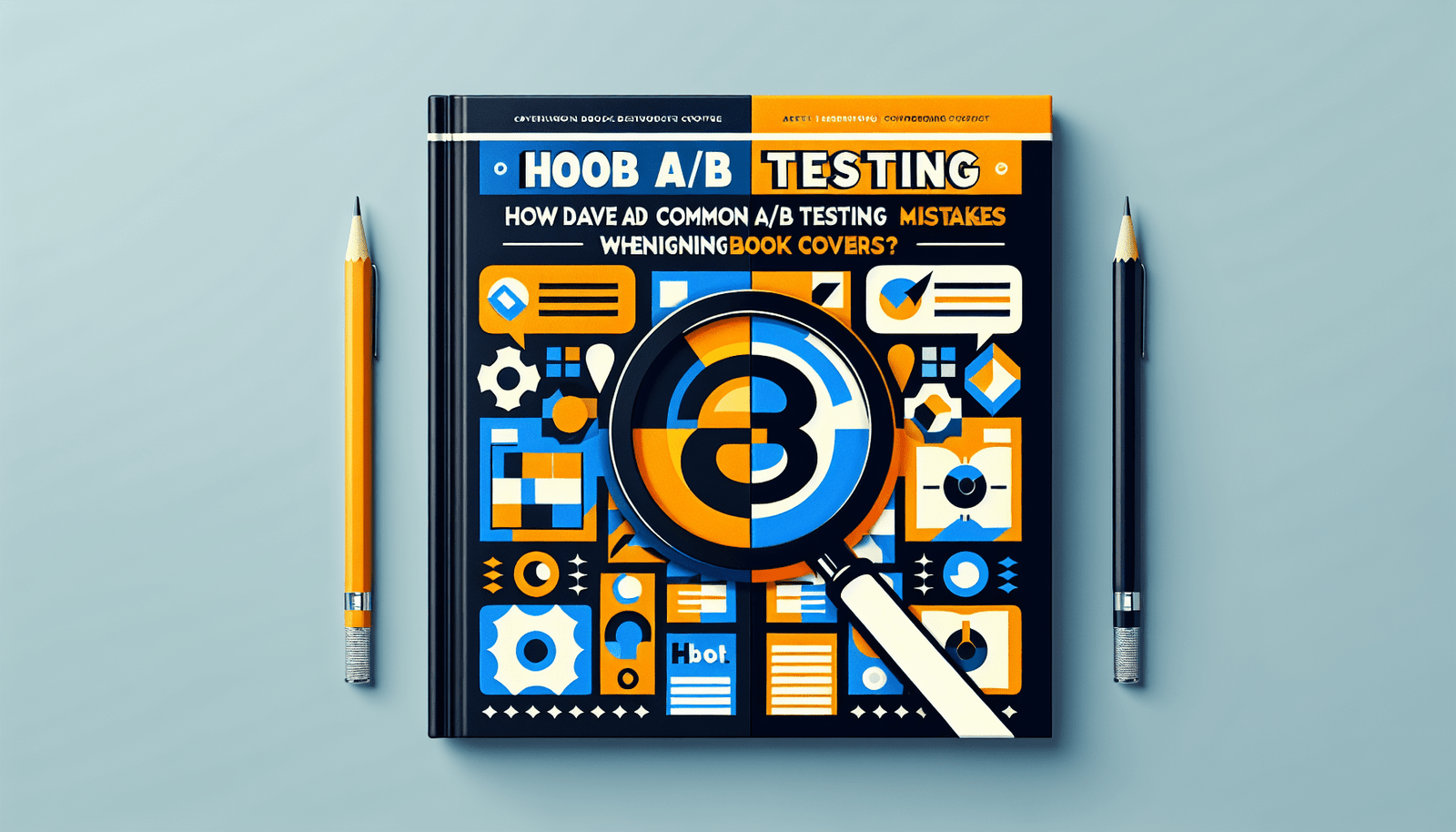When designing book covers, avoiding common A/B testing mistakes can significantly enhance your ability to captivate potential readers. This article, “How Can You Avoid Common A/B Testing Mistakes When Designing Book Covers,” equips you with practical strategies to conduct effective A/B tests. You’ll learn to identify critical testing pitfalls, understand the importance of proper sample sizes, and make data-driven decisions that ultimately lead to the most compelling cover design for your book.
Have you ever wondered why some book covers captivate you while others barely catch your eye? The secret often lies in A/B testing, a powerful tool that helps you determine the most appealing design by comparing two or more variations. But beware, while A/B testing can guide you to make informed decisions, it’s fraught with pitfalls that can derail your efforts.
In this friendly guide, we’ll walk you through how to avoid common A/B testing mistakes when designing book covers, ensuring that you make choices that truly resonate with your audience.
What is A/B Testing in Book Cover Design?
A/B testing, or split testing, involves presenting two (or more) variations of a book cover to your target audience to determine which one performs better. This method allows you to gather quantitative data, helping you make decisions based on real user preferences rather than assumptions.
The concept is simple: you create different versions of a book cover and expose them to similar audience segments. By measuring key metrics like click-through rates (CTR), conversions, or engagement, you can identify which cover is more effective.
Why A/B Testing is Crucial for Book Covers
Why bother with A/B testing when you could simply choose a design you like? The answer lies in the subjectivity of visual appeal. What looks good to you might not be appealing to your target audience. A/B testing removes this subjectivity, allowing you to make data-driven decisions that can significantly impact your book’s success.
A well-designed cover can:
- Increase Sales: A compelling cover is often your first and most crucial marketing tool.
- Enhance Visibility: Attracting more eyeballs means better chances of your book being noticed.
- Build Brand Identity: Consistent, appealing covers help in establishing your author brand.
Common Mistakes to Avoid
While A/B testing is a powerful tool, it’s easy to fall into some common traps. Let’s explore these pitfalls and how you can steer clear of them.
Rushing the Testing Process
One of the biggest mistakes you can make is rushing through the A/B testing process. While it’s tempting to get quick results, hasty decisions can lead to inaccurate data.
Solution: Take your time to properly design and execute your A/B tests. Allow for a sufficient testing period to gather enough data.
Ignoring Sample Size
The accuracy of your A/B testing hinges on sample size. Too small a sample, and your results may not be statistically significant.
Solution: Use a sample size calculator to determine the number of participants needed for reliable results. Aim for a larger sample size to increase the validity of your findings.
Testing Too Many Variables
While it might seem efficient to test multiple variables at once, this can muddle your results and make it difficult to pinpoint which changes led to a particular outcome.
Solution: Focus on one variable at a time. For example, test two different fonts or two different images, but not both simultaneously.
Overlooking External Factors
Seasonality, current events, or even the day of the week can influence the results of your A/B test.
Solution: Conduct multiple tests over different times and conditions to ensure your findings are robust and not skewed by external factors.
Not Defining Clear Goals
Without precise goals, it’s challenging to measure the success of your A/B test.
Solution: Define clear, measurable objectives before you begin. Are you looking to increase click-through rates? Boost sales? Whatever it is, make sure it’s quantifiable.
Failing to Act on Results
Collecting data is pointless if you don’t act on it. Ignoring the test results and going with your gut feeling wastes time and resources.
Solution: Trust the data and be prepared to make changes based on your findings.
Misinterpreting Results
Lastly, a common mistake is misinterpreting the results due to lack of statistical know-how.
Solution: Familiarize yourself with basic statistical concepts or consider consulting with a data analyst to ensure your interpretations are accurate.
Steps to Effective A/B Testing
Now that we’ve outlined the common pitfalls, let’s delve into a step-by-step guide to effective A/B testing.
Step 1: Define Your Objective
Before you start designing your book covers, clearly define what you aim to achieve with your A/B test. This could be higher click-through rates, better sales conversion, or deeper engagement.
Step 2: Choose Your Variables
Decide on the aspects of your book cover to test. This can include:
- Title Font: Does a serif or sans-serif font resonate more?
- Color Scheme: Which colors attract more attention?
- Image: Does the audience prefer a photograph or illustration?
- Layout: How does the placement of elements affect interaction?
Step 3: Create Variations
Design two or more versions of the book cover, making sure each differs only in the variable you are testing.
| Variable | Option A | Option B |
|---|---|---|
| Title Font | Serif | Sans-serif |
| Color Scheme | Blue/White | Red/Black |
| Image | Photograph | Illustration |
| Layout | Centered Title | Top Aligned Title |
Step 4: Segment Your Audience
Segment your audience into groups that will be exposed to different versions of the cover. Ensure that the groups are similar in demographic and psychographic aspects to maintain the test’s validity.
Step 5: Run the Test
Conduct the A/B test over a significant period. The length will depend on your sample size and the metrics you are measuring. The goal is to gather enough data to ensure the results are statistically significant.
Step 6: Analyze the Results
After the testing period, analyze the data to see which cover performed better. Use statistical tests to ensure the significance of your results.
Step 7: Implement the Winning Design
Once you have identified the winning design, implement it. Keep monitoring its performance to ensure it continues to meet your objectives.
Best Practices for A/B Testing
Start with Hypotheses
Make educated guesses about what you think will perform better and why. This provides a framework for your tests and makes it easier to interpret the results.
Use Statistical Significance
Always look for statistical significance in your results. This means that the differences you observe are unlikely due to random chance.
Test One Variable at a Time
As mentioned earlier, testing one variable at a time helps you pinpoint exactly what element is making the difference.
Use Reliable Tools
Utilize reliable A/B testing tools:
- Google Optimize
- Optimizely
- VWO
- HubSpot’s A/B Testing Kit
Monitor Long-term Performance
Don’t just stop at short-term gains. Monitor long-term performance to ensure your chosen design continues to perform well over time.
Iterate Based on Feedback
Listen to your audience and be prepared to iterate on your design. The marketplace and user preferences are constantly evolving, and so should your designs.
Real-World Examples and Case Studies
Example 1: Font Changes
An independent author tested two book covers with different fonts. One used a classic serif font for the title, while the other used a modern sans-serif font. Over a month, the serif font received a 15% higher click-through rate, leading to its adoption.
Example 2: Color Scheme
A publishing house experimented with blue/white and red/black color schemes for a mystery novel. Surprisingly, the red/black cover showed a 20% increase in engagement, prompting a complete rebranding of the series.
Example 3: Image Selection
A self-help book tested a cover featuring a smiling individual against one showcasing calming nature imagery. The nature imagery won by a significant margin, resonating more with the target audience.
Conclusion
A/B testing is not just a method; it’s an art and science that, when done correctly, can greatly enhance the appeal and success of your book covers. By avoiding common mistakes such as rushing the process, ignoring sample size, and not acting on results, you can ensure that your A/B testing efforts are both effective and illuminating.
Take your time, follow the steps, and always be prepared to iterate based on the data you collect. Armed with these insights, you’ll be better equipped to design book covers that not only stand out but also connect deeply with your audience. Happy testing!



